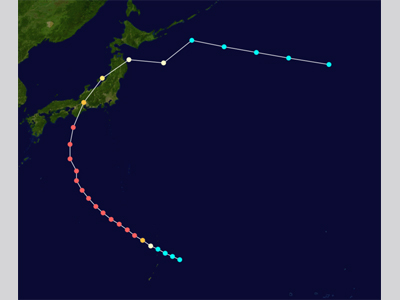Super Typhoon Vera had very modest beginnings. It started as an area of low pressure on September 20, 1959 in the western Pacific Ocean between Guam and the southwest Pacific island group of Chuuk. The system began to slowly intensify while located about 480 km (300 mi) east of the island of Saipan. Late on 21 September, it was determined that Tropical Storm Vera had formed. At about the same time the next day, Vera had intensified to typhoon status with winds of 138 km/h (86 mph). From this point, the storm rapidly strengthened due its presence over warm waters. Typhoon Vera became a super typhoon, equivalent to a Category 5 hurricane on the Saffir-Simpson Hurricane Wind Scale, on 23 September. Vera reached peak intensity that day with winds of 306 km/h (190 mph) and a low pressure of 896 mb.
Over the next couple days, the storm tracked northwest at a speed of about 19 km/h (12 mph) with little change in intensity. Normally, super typhoons weaken after peaking due to upwelling or other weather factors. Super Typhoon Vera, however, maintained incredible strength as it moved towards Japan. On 25 September, the storm began to curve northward while accelerating to a speed of 34 km/h (21 mph). The next morning, Typhoon Vera slammed into the southeast coast of Japan at the Wakayama Prefecture, in the Kansai Region (said to be the cultural and historical heart of the nation). The landfall was accompanied by a storm surge of 4 m (13 ft), sustained winds of at least 161 km/h (100 mph) and frequent gusts to 257 km/h (160 mph). Sustained wind speeds of at least 80 km/h (50 mph) were experienced throughout the length of the island nation from Hokkaido in the north to Kyushu in the south. The storm weakened as it quickly traversed Honshu, the largest island of Japan, in six hours, moving at 61 km/h (38 mph) in a northeasterly direction. Vera reemerged into the Pacific Ocean as a minimal typhoon on 27 September only to become extratropical on the 28 September after interacting with a polar front. Typhoon Vera caused an astounding amount of damage in Japan. Much flooding occurred throughout the country, as 102-204 mm (4-8 in) of rain fell during the typhoon’s passage. The majority of the storm’s damage occurred at areas along the southeast coast. At Ise Bay, some 177 km (110 mi) from the point of landfall, pounding surf collapsed banks and inundated low-lying areas. The wave action damaged or completely destroyed 149,187 homes, decimating the modern day city of Nagoya and rendering its harbor useless. The strength and extent of the storm’s winds caused storm surge to flood 310 km2 (120 mi2) of land. Earthen levees, initially protecting areas along the northern part of Ise Bay, were breached allowing water to pour into the populated area for days following the storm – a scenario similar to New Orleans in the days after Hurricane Katrina (2005). These areas remained flooded for up to four months. The contaminated floodwaters produced wide outbreaks of diseases including dysentery and gangrene, and supplies of fresh drinking water dwindled quickly. Food shortages were widespread as the storm destroyed large areas of crops, many which had been ready for harvest. These crop losses and the destruction of cities and railways caused great economic suffering in Japan. In all, over 5,000 people were killed as a result of Super Typhoon Vera. 38,921 individuals went missing and 1,596,855 people were made homeless. Total damages amounted to between 500-600 billion yen (about $261 million [1959 USD] or $1.67 billion [2007 USD]). The severe storm conditions of Super Typhoon Vera caused the most of destruction and loss of life of any tropical cyclone in Japanese history. Fast Facts:
Sources:
Hoffman, Robert M. “Annual Typhoon Report.” San Francisco: Joint Typhoon Warning Center (JTWC). 1959. Pp. 110, 111, 189, 190. Web. 1959 Super Typhoon Vera: 50 Year Retrospective. Risk Management Solutions (RMS). 2009. Web. Typhoon Vera (1959). Wikipedia. 2009. Web. Ise Bay. Wikipedia. 2009. Web. < http://en.wikipedia.org/wiki/Ise_Bay> Oda, Hideaki. “Typhoon Isewan (Vera) And Its Lessons.” Japan Water Forum. 2005. Web. “Vera Track” “Track 2” Also some images here, thought they are awfully low quality: |


